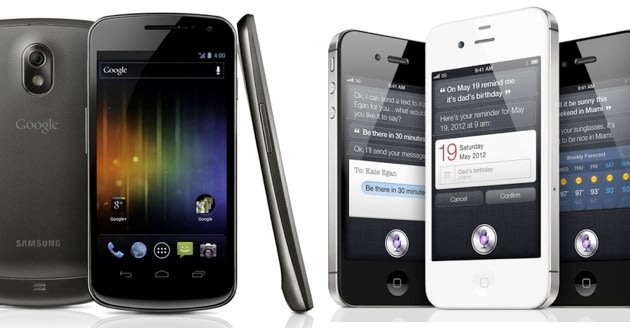
Android and the iPhone may seem like oil and water — at least depending on who you ask — but the two major forces in the smartphone world are starting to increasingly take their cues from one another. Apple just introduced iOS 5, the newest version of its wildly popular mobile operating system, and now Google's let the cat out of the bag on Android 4.0 (playfully nicknamed "Ice Cream Sandwich") and a new flagship phone, the powerhouse Samsung Galaxy Nexus. Android 4.0 seeks to remedy the most common complaints about Android: namely its complexity (and the fact that it isn't the indomitable iPhone). Read on to see how the two mobile heavyweights fare in a head-to-head match.
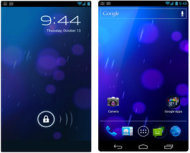
The sleek interface of Ice Cream Sandwich
If you've spent any time with an Android tablet, you've seen theTron-esque stark black visual landscape that Google has now ported over to Android for phones. Thought up by lauded mobile designer Matias Duarte, the look is a somewhat radical new direction: A sleek retort to the simplicity of iOS that stands apart with deep blacks, glowing blues, and an ultra-modern new font called Roboto. Android 4.0 also tosses resizable widgets into the mix, making it even easier to get weather, email, texts, and more without opening an app.
Apple's iOS 5 doesn't introduce much in the way of a visual redesign, but why mess with a winning formula? As far as function goes, iOS 5 does introduce an extremely useful pull-down notification system that replaces the incessant pop-ups of yore, though Apple admittedly took its inspiration from Android.
Winner: Android 4.0 Android's new look is striking and innovative (even if it isn't everyone's cup of tea). The visual style of iOS is clean by definition, but it doesn't have the pizazz of the new blue Android 4.0 and didn't evolve nearly as far in the last update.
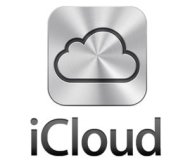
Apple's iCloud automates you backup needs
Apple has made much ado about iCloud, its brand new iOS 5 feature that zaps your downloads to the cloud and syncs iTunes downloads like apps, music, and photos them across your iDevices. If you're a former MobileMe user you'll be happy to know that the service is now free, and rolled up under the banner of iCloud for email, contact, and calendar syncing.
Integration with the cloud has always been a strong suit for Google. While Google Music Beta might have been upstaged by on-demand cloud music darling Spotify, Google's vast suite of software services are quite handy on Android compared to their iOS counterparts. Apps like Gmail offer a richer, deeper experience on Google's own platform, and with Android 4.0, Google has upped the game with enhanced offline email search (up to 30 days back), a functional redesign to make things simpler and smoother, and a revamped Calendar app.
Winner: Tie If you're more plugged into iTunes and the service formerly known as MobileMe, Apple's software will make your life a breeze. If you lean more heavily on Gmail, Google Calendars, and the like, Android is built for you.
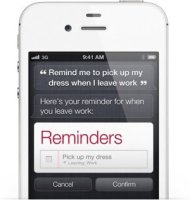
Siri on the iPhone 4S is an advanced AI
Both iOS 5 and Android 4.0 have a futuristic touch — and we're not just talking glowing blue tones either. With iOS 5, Apple introduced us to Siri, a voice command and search app that's almost eerily sophisticated. You can speak into your iPhone 4S and ask Siri anything you want (really, anything!) and Siri speaks the information you need — or least a quirky retort. Android has boasted handy built-in voice commands for longer, but Siri is far more comprehensive...and far closer to being sentient.
Paired with the futurescape of its new look, Android 4.0 introduces two very cool little bonus features: Android Beam and Face Unlock. If you've ever used the clever app Bump to swap phone numbers, Beam is the exact same idea, but expanded. With Beam, you can tap two phones together and watch as websites, videos, directions, and apps are zapped from one phone to the other.
Face Unlock for Android 4.0 is a trick that could prove pretty useful in securing your phone from prying eyes. Using Google's face recognition technology, you can unlock your phone just by peering into the front-facing camera and having your face recognized.
Winner: Siri Both Apple and Android's new futuristic features have some inherent limitations. Siri is only available for the iPhone 4S, and isn't open to all iOS 5 users. Android Beam will debut on the new flagship Galaxy Nexus phone, and then be possible between any two Android 4.0 phones that have a Near-Field Communication (NFC) chip or sticker. Unfortunately, knowing Google's checkered past with Android updates and its ongoing struggles with its grab bag of Android makers, it's hard to say how long it'll be before the stars will align for Beam.
Winner: Siri Both Apple and Android's new futuristic features have some inherent limitations. Siri is only available for the iPhone 4S, and isn't open to all iOS 5 users. Android Beam will debut on the new flagship Galaxy Nexus phone, and then be possible between any two Android 4.0 phones that have a Near-Field Communication (NFC) chip or sticker. Unfortunately, knowing Google's checkered past with Android updates and its ongoing struggles with its grab bag of Android makers, it's hard to say how long it'll be before the stars will align for Beam.
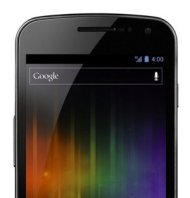
Samsung Galaxy Nexus
While the iPhone 4S is no iPhone 5, it's no slouch either. The phone isn't radically redesigned, but it's got a huge boost in speed thanks to an A5 processor, an even better camera with an 8MP sensor andf/2.4 aperture, and then there's Siri behind the wheel, and the winning design and retina display introduced with the last generation iPhone.
There's a veritable sea of Android phones out there, but the new reigning champion is the Galaxy Nexus, made by Samsung and due out next month. As the latest in Google's bloodline of Nexus flagship phones, it will be the first phone running Android 4.0 out of the gate — a huge advantage in our crazy, mixed up Android world.
Samsung Galaxy Nexus tech specs:
- 4.65" Super AMOLED screen
- 1.2Ghz dual-core processor
- Support for 4G LTE
- Sliver-thin 9mm thickness
- Curved design that makes it feel natural to hold
- Android 4.0
- NFC
Winner: iPhone 4S In terms of screen quality, speed, and design, these two phones are clearly the very upper crust of the mobile world. They're very nearly equally matched, but the Galaxy Nexus does have a few tricks up its sleeve, with the ability to connect to true 4G networks — not to mention NFC, a burgeoning technology in mobile payments that's set to explode. Still, the iPhone 4S is a better fit for the average buyer. The flagship Android phone's huge screen will be great for multimedia, but at a whopping 4.65", it's just plain too big to have the same broad appeal as a more modestly-sized device.
Now that Apple has snagged (and refined) some of Android's killer features like voice commands and the drop-down notification window, the iPhone is more of a force to be reckoned with than ever — even if it did play dirty. The Galaxy Nexus is an extremely powerful phone, but there will (hopefully) soon be many more Android 4.0 devices floating around, and none can stay on top for long. For its broad appeal and refined operating system, this round goes to the one and only iPhone.
This article originally appeared on Tecca


